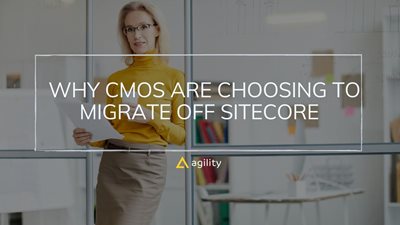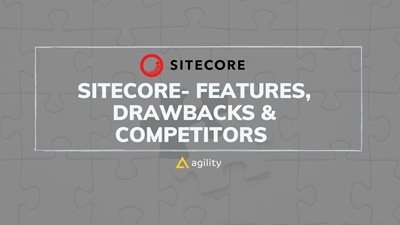Content Migration: From Monolith to Composability


Sitecore was one of the first Enterprise CMSs in the market. The platform has spearheaded CMS adoption for over two decades and inspired many other CMSs currently disrupting the sector.
While their experience in the field is excellent, the CMS market values functionality more than reputation. Going composable, Agility's Headless capabilities include increased flexibility and scalability. Separating the presentation layer –the front end– from the content management layer –the database allows for more modularity and future-proofing.
This can be especially beneficial for companies that want to move away from a monolithic platform like Sitecore and build their website on top of a modern stack.
Agility is a top contender if you're looking to migrate from a monolith to a Content Platform capable of orchestrating composable digital experiences!
However, there are a few things you need to consider before taking the plunge. To help you set everything straight, we'll outline the steps you need to take before migrating, along with some reasons why monoliths are a thing of the past, and composable architecture is the future.
Why Not Build a Monolith?
For decades, most software was built as a monolith, a software architecture where all the application parts are interconnected and often interdependent, king as a self-contained whole.
Back then, it made sense to build monoliths because they made the early stages of application development more accessible, but that's not the case anymore, thanks to the headless architecture.
While monoliths Sitecore have been making overtures to the headless architecture and composable approach, it's still not the best choice to make, mainly due to three factors:
- Cost: Scaling monolithic applications is not only painful but also often inefficient. While a monolith can be scaled horizontally with relative ease –add a load balancer and as many instances of the application as are required– this approach can be overly expensive.
- Security: Since everything is interconnected, when one element has an error, it can impact many other features or crash the program entirely. The same happens with vulnerabilities, as a single attack vector can compromise your entire website or app.
- Maintainability: Every app grows in complexity as time goes by, causing your codebase to become large and difficult to manage. In monolithic apps, changing one function can break another part somewhere else in the code that relied on it. This means that even in the case of a minor update to a single feature, the entire application must be recompiled and tested.
Read More: 5 Steps: Monolithic to Microservices Architecture
Why is Composable Architecture the Future?
Composability means creating software products using interchangeable blocks composed of microservices and frameworks, just like you would with a Lego set. This approach is contrary to monolithic architecture primarily due to these reasons:
- Services-based: Your applications are built on independent services that work together in sync.
- Pick what you need: Choose your adventure and build your applications using your favourite tool stack.
- Grows with you: You can swap services and keep your application going without re-architecture everything.
- Secure and scalable: Scale only the services you need instead of your whole architecture while preventing unscrupulous actors from meddling with your system.
All in all, composability breaks down monolithic applications into discrete components. Each component can be built, scaled, and maintained independently, enabling businesses to adopt new technologies and processes.
3 Reasons to Migrate to a Composable Platform
- Complete Control Over Your Content and Workflows
A composable platform like Agility CMS gives you complete control over your content, allowing you to model each piece of content to build custom digital experiences. Agility also will enable you to create workflows to streamline approval processes.
- Fast Product Delivery
Agility CMS allows for a phased delivery using modern development frameworks and DevOps techniques to increase ROI.
- Better UX
Agility CMS allows developers to build clean, snappy UIs that delight users and simplify navigating. At the same time, composability is excellent for developer experience as it removes the constraints monolithic architecture places on them.
Watch: How Composability is Disrupting Legacy DXP
How to Migrate From Monolith to Composable Solution
Assess Your Needs
Migrating just for the sake of it will leave you financially and emotionally drained. Before ditching Sitecore, you must evaluate your existing implementation and see if you need to make the switch.
Dig deep and see your current pain points and how Agility could help you solve them. Also, be clear on your expectations and establish a risk mitigation plan to reduce the possibility that such a project could hurt your customers or visitors.
Be Clear on What You Want From Your New Solution
We all want the perfect solution. But the reality is there's no perfect one. You can build your show with a composable solution like Agility CMS. However, that doesn't mean you don't have to be clear on what you need from your CMS in terms of features and technologies. You can only create the perfect composable platform if you know what you want to achieve. Otherwise, you'll always be scrambling for new features and functionalities, resulting in an unwieldy, haphazardly built platform.
Choose Your Tech Stack
Once you know your business and features needs, take a long, hard look at your existing toolchain and see if it can be integrated with your composable platform.
If you're migrating to Agility CMS, chances are they can be combined. Agility CMS allows you complete freedom to choose what works for you and orchestrates every piece of your tool stack to work in sync.
Plan Phase One of Your Migration,
Here's where planning starts. By this point, you've probably conceptualized your migration and have a series of requirements, and that's great. It's time to get to work.
If you're working with an agency, we recommend you look at Agility's partners– make sure you mention your specific requirements in terms of security, scalability, stability, and performance. Also, remember to start small or with less critical parts of your website so you can see how things would work without burning your resources or frustrating your team.
Train Your Team
Training often goes overlooked, even though it's one place you should focus more on. Agility and its partners provide extensive documentation and resources to ensure a smooth transition.
Failing to train your collaborators properly can derail your migration. Even the best plans can fail due to human error or poor adoption by your collaborators. To prevent that, find a champion. Someone who knows about composability and headless architecture is driven to spearhead change.
Prepare Your Content
It's essential to structure your content correctly so it can be reused. For this process, you'll first need to determine what reusable structures are being created. Then use metadata appropriately and attributes depending on how it's categorized into taxonomies.
Let's break that down a bit further.
The first step in creating reusable content is to determine what type of items you'll be using it for and how they should best carry their information. The best way to structure your content is by determining what type of things you'll be putting in it and then correctly categorizing them with taxonomies. You can also define relations between different types if needed.
Deploy and Secure Your Website
Don't wait until you're close to the deployment of Phase 1 before you think about DevOps. Instead, set this up on day 1 with proper source control, the main branch, and optional branches for QA and UAT.
Then, before it comes time to go live, sit down with your team and as many stakeholders as possible to build a checklist of all the things that need to happen. Since getting simple things like DNS changes can sometimes take many approval processes and days of calendar time, make sure to have those things ready to go well ahead of your launch schedule.
Get Started With Composability With Agility
All in all, leveraging the right technologies combined with the right implementation partner is the best way to get your foot on the composable door. It can help you build a future-proof, resilient composable platform that results in better customer experiences and more media formats, such as web pages or mobile applications across various channels.
Agility is the best choice if you're looking for a modern, headless CMS that can easily integrate with your existing Sitecore installation. Our platform is designed to make migrating from a monolithic digital experience platform like Sitecore easy and painless so that you can take advantage of the benefits of a decoupled architecture immediately.
If you have questions about our platform or how we can help you migrate from Sitecore, watch this video where Joel Varty, Tim Benniks, and Marcelo Lewin talk about why companies should think about migrating to a composable architecture:

About the Author
Harmonie is the Senior Marketing Manager at Agility CMS
View Related Resources

Why CMOs are Choosing to Migrate Off Sitecore

What is Sitecore CMS and its competitors?

